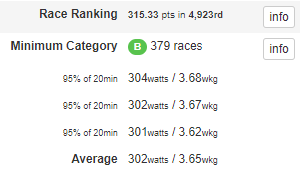Categories are an integral part of Zwift racing, and it would seem that the boundary lines are clearly spelled out on ZwiftPower, where race results are verified and finalized:
Mixed Races
- A+: 4.6w/kg and 300w FTP
- A: 4w/kg and 250w FTP
- B: 3.2w/kg and 200w FTP
- C: 2.5w/kg and 150w FTP
Women’s Races
- A: 3.7w/kg
- B: 3.2w/kg
- C: 2.5w/kg
While in-game enforcement of these categories still has a long way to go, these category boundaries are used by the vast majority of Zwift races today top create an environment of inclusive, fair competition.
But after observing many Crit City races, and the social media traffic they generate, I think there’s an interesting rabbit hole we can travel down together to see how Zwift’s race categorization system could be improved.
ZwiftPower Categorization Primer
First, let’s make sure we’re all on the same page in understanding how categorization actually works in all the Zwift races which are run through ZwiftPower.

Every ZwiftPower-registered rider has a category assigned to them based on their race history. This category is defined as the “average of best 3 races in last 90 days”. To be specific, this is 95% of your best 20-minute power, which is the formula commonly used to estimate FTP. We’ll call this your “FTP Wattage”.
Example: according to ZwiftPower, my strongest three races in the last 90 days had the following FTP wattage:
- 304watts / 3.68wkg
- 302watts / 3.67wkg
- 301watts / 3.62wkg
This means my average FTP wattage is 302w, or 3.65w/kg. This places me squarely in the B category, which is for anyone with an FTP wattage of at least 200w and 3.2w/kg, but under 4w/kg.
Two Key Conditions
ZwiftPower categorization as described above works decently well, but only if two conditions are met:
- Everyone is signed up for ZwiftPower: currently, any Zwifter can join any race, even if they aren’t signed up for ZwiftPower. If they aren’t signed up with ZwiftPower, they won’t show in the final results there. But they can still dramatically affect the race! This is a major concern, but outside the scope of this article.
- Everyone races in their proper category in the Zwift event: currently, Zwifters can race in whatever category they’d like. That means an A-level pro can ride in a D race and blow away the field, if they so choose. This is what we call “sandbagging”, and relates somewhat to the topic at hand.
What Is Your FTP?
So, we understand now that ZwiftPower automatically detects your FTP based on race efforts as described above. That FTP then determines your ZwiftPower race category, which determines the category(s) you can legally race.
But here’s the thing: the length of races you enter will directly impact your 20-minute power numbers. For example, think of how your 20-minute max power would probably look in a 2+ hour 100km race compared to an 8-lap Crit City race lasting ~22 minutes.
In long events, riders must race at an average wattage well below their FTP, since it’s impossible to hold your FTP power for 2+ hours. Conversely, riders would be expected to ride slightly above FTP in a max effort 20-minute event.
Clearly, ZwiftPower’s computed FTP is very much a function of race length. If I only race long events, my computed FTP will logically be lower than if I only race 20-minute events. Let’s keep heading down this rabbit hole…
Game-Changing Short Races
Short races appeared on Zwift years ago, when WBR began holding regular “sprint” events. But the shorter race format truly exploded in December 2019/January 2020, when Crit City was unveiled and 8-lap races made their way onto the daily calendar. Suddenly, thousands of racers (myself included) were taking part in much shorter races than before.
Most of my races were 50-70 minutes long, before Crit City arrived. Now many of my races are only 20 minutes long! For myself and other riders, the 8-lap Crit City race has become a sort of “fun FTP test”.
Has this changed my computed FTP on ZwiftPower? Absolutely. Because I can remember only one time in my Zwift racing history that I joined a race with the specific goal of going all-out for the first 20 minutes, to treat it like an FTP test. But when I take on Crit City races (especially an A-level race!) it can be a 20-minute max effort every time.
And so we arrive at my thesis statement: that many racers have seen their ZwiftPower-computed FTP increase due to their involvement in short Crit City races, and this has, in turn, forced them to upgrade to the next category.
Earth-shattering conclusion? Not exactly. And I don’t have access to the data required to prove my thesis. But it seems to be a very logical and rational conclusion, and if it’s true, it’s a “game-changer” – at least for those forced to upgrade.
Your Comments
If my thesis is true, then two identical riders might now be categorized differently, regardless of race results, simply because one chooses to race Crit City 8-lappers, while the other does not.
My thoughts on some of the shortcomings of the current categorization scheme have been explained in previous posts, and I think this example may illustrate some additional weaknesses. But I will leave this discussion to you, dear reader. Thanks for jumping down the rabbit hole with me today. Please share your thoughts below!

